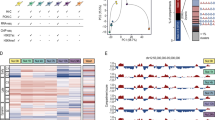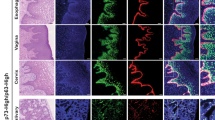Abstract
Activating enhancer-binding protein 2α (AP-2α) and activating enhancer-binding protein 2γ (AP-2γ) are transcription factors that bind GC-rich consensus sequences and regulate the expression of many downstream genes. AP-2α and AP-2γ interact with p53 both physically and functionally. Expression microarray results in human breast carcinoma cells with forced p53 expression revealed AP-2γ as a putative transcriptional target of p53. To confirm and extend these findings we measured the effects of forced p53 expression in human breast carcinoma cells by real-time reverse transcription–PCR, Western blotting, electrophoretic gel mobility shift assays, promoter reporter, chromatin immunoprecipitation and chromatin accessibility assays. Wild-type p53 expression rapidly induced not only AP-2γ but also AP-2α mRNA. The subsequent increase in these proteins led to increased AP-2 DNA-binding and transactivating activity. Candidate p53-binding sites were identified in the AP-2α and AP-2γ promoters. p53 binding to these cis-elements in vivo was also observed, together with a relaxation of chromatin structure in these regions. Finally, expression of either AP-2α or γ inhibited growth of human breast carcinoma cells in vitro. Taken together, our findings indicate that these AP-2 genes are targets for transcriptional activation by p53 and suggest that AP-2 proteins may mediate some of the downstream effects of p53 expression such as inhibition of proliferation.
This is a preview of subscription content, access via your institution
Access options
Subscribe to this journal
Receive 50 print issues and online access
$259.00 per year
only $5.18 per issue
Buy this article
- Purchase on Springer Link
- Instant access to full article PDF
Prices may be subject to local taxes which are calculated during checkout






Similar content being viewed by others
References
Bar-Eli M . (2001). Pigment Cell Res 14: 78–85.
Chen P, Lin S, Wang C, Chen Y, Chen T, Chang J . (1993). Clin Chem 39: 2186–2191.
Donehower LA, Harvey M, Slagle BL, McArthur MJ, Montgomery CA, ButelAllanBradley JS . (1992). Nature 356: 215–221.
Douglas DB, Akiyama Y, Carraway H, Belinsky SA, Esteller M, Gabrielson E et al. (2004). Cancer Res 64: 1611–1620.
Gee JMW, Robertson JFR, Ellis IO, Nicholson RI, Hurst HC . (2000). J Pathol 189: 514–520.
Hilger-Eversheim K, Moser M, Schorle H, Buettner R . (2000). Gene 260: 1–12.
Huang S, Jean D, Luca M, Tainsky MA, Bar-Eli M . (1998). EMBO J 17: 4358–4369.
Huang Y, Domann FE . (1998). Biochem Biophys Res Commun 249: 307–312.
Hursting S, Perkins S, Phang J . (1994). Proc Natl Acad Sci USA 91: 7036–7040.
Jean D, Gershenwald JE, Huang S, Luca M, Hudson MJ, Tainsky MA et al. (1998). J Biol Chem 273: 16501–16508.
Karjalainen J, Kellokoski J, Eskelinen M, Alhava E, Kosma V . (1998). J Clin Oncol 16: 3584–3591.
Karjalainen JM, Kellokoski JK, Mannermaa AJ, Kujala HE, Moisio KI, Mitchell PJ et al. (2000). Br J Cancer 82: 2015–2021.
Koster MI, Kim S, Huang J, Williams T, Roop DR . (2006). Dev Biol 289: 253–261.
Litt MD, Simpson M, Recillas-Targa F, Prioleau MN, Felsenfeld G . (2001). EMBO J 20: 2224–2235.
Marreiros A, Czolij R, Yardley G, Crossley M, Jackson P . (2003). Gene 302: 155–164.
McPherson L, Weigel R . (1999). Nucleic Acids Res 27: 4040–4049.
McPherson LA, Loktev AV, Weigel RJ . (2002). J Biol Chem 277: 45028–45033.
Mills AA, Zheng B, Wang XJ, Vogel H, Roop DR, Bradley A . (1999). Nature 398: 708–713.
Modugno M, Tagliabue E, Ardini E, Berno V, Galmozzi E, Bortoli MD et al. (2002). Nature 21: 7478–7487.
Oshiro MM, Watts GS, Wozniak RJ, Junk DJ, Munoz-Rodriguez JL, Domann FE . (2003). Oncogene 22: 3624–3634.
Paggi MG, Bonetto F, Severino A, Baldi A, Battista T, Bucci F et al. (2001). Oncogene 20: 2570–2578.
Pellikainen J, Kataja V, Ropponen K, Kellokoski J, Pietilainen T, Bohm J et al. (2002). Clin Cancer Res 8: 3487–3495.
Petsko G . (2002) In: Current Protocols in Bioinformatics: Modeling Structure from Sequence Baxevanis AD (ed). John Wiley and Sons Inc.: Indianapolis, IN.
Polyak K, Xia Y, Zweier JL, Kinzler KW, Vogelstein B . (1997). Nature 389: 300–305.
Ruiz M, Troncoso P, Bruns C, Bar-Eli M . (2001). Clin Cancer Res 7: 4086–4095.
Schorle H, Meier P, Buchert M, Jaenisch R, Mitchell PJ . (1996). Nature 381: 235–238.
Stabach PR, Thiyagarajan MM, Woodfield GW, Weigel RJ . (2005). Oncogene [E-pub ahead of print, PMID: 16288208[].
Tellez C, McCarty M, Ruiz M, Bar-Eli M . (2003). J Biol Chem 278: 46632–46642.
Tummala R, Romano RA, Fuchs E, Sinha S . (2003). Gene 321: 93–102.
Vogelstein B, Lane D, Levine AJ . (2000). Nature 408: 307–310.
Wajapeyee N, Somasundaram K . (2003). J Biol Chem 278: 52093–52101.
Watts GS, Oshiro MM, Junk DJ, Wozniak RJ, Watterson S, Domann FE et al. (2004). Neoplasia 6: 187–194.
West-Mays JA, Sivak JM, Papagiotas SS, Kim J, Nottoli T, Williams T et al. (2003). Differentiation 71: 206–216.
Williams T, Admon A, Luscher B, Tjian R . (1988). Genes Dev 2: 1557–1569.
Yang A, Schweitzer R, Sun D, Kaghad M, Walker N, Bronson RT et al. (1999). Nature 398: 714–718.
Yu J, Zhang L, Hwang PM, Rago C, Kinzler KW, Vogelstein B . (1999). Proc Natl Acad Sci USA 96: 14517–14522.
Zeng YX, Somasundaram K, el-Deiry WS . (1997). Nat Genet 15: 78–82.
Zhang J, Hagopian-Donaldson S, Serbedzija G, Elsemore J, Plehn-Dujowich D, McMahon AP et al. (1996). Nature 381: 238–241.
Zhao F, Satoda M, Licht JD, Hayashizaki Y, Gelb BD . (2001). J Biol Chem 276: 40755–40760.
Zhu C-H, Huang Y, Oberley LW, Domann FE . (2001). J Biol Chem 276: 14407–14413.
Acknowledgements
This work was supported by NIH Grants CA66081, CA73612 and CA65662 and The University of Iowa Gene Transfer Vector Core. The authors also thank Drs Bert Vogelstein and Ronald Weigel for providing valuable reagents.
Author information
Authors and Affiliations
Corresponding author
Additional information
Supplementary Information accompanies the paper on the Oncogene website (http://www.nature.com/onc)
Rights and permissions
About this article
Cite this article
Li, H., Watts, G., Oshiro, M. et al. AP-2α and AP-2γ are transcriptional targets of p53 in human breast carcinoma cells. Oncogene 25, 5405–5415 (2006). https://doi.org/10.1038/sj.onc.1209534
Received:
Revised:
Accepted:
Published:
Issue Date:
DOI: https://doi.org/10.1038/sj.onc.1209534
Keywords
This article is cited by
-
A global genomic view on LNX siRNA-mediated cell cycle arrest
Molecular Biology Reports (2011)
-
The guardians of the genome (p53, TA-p73, and TA-p63) are regulators of tumor suppressor miRNAs network
Cancer and Metastasis Reviews (2010)
-
A Functional Enhancer of Keratin14 Is a Direct Transcriptional Target of ΔNp63
Journal of Investigative Dermatology (2007)



